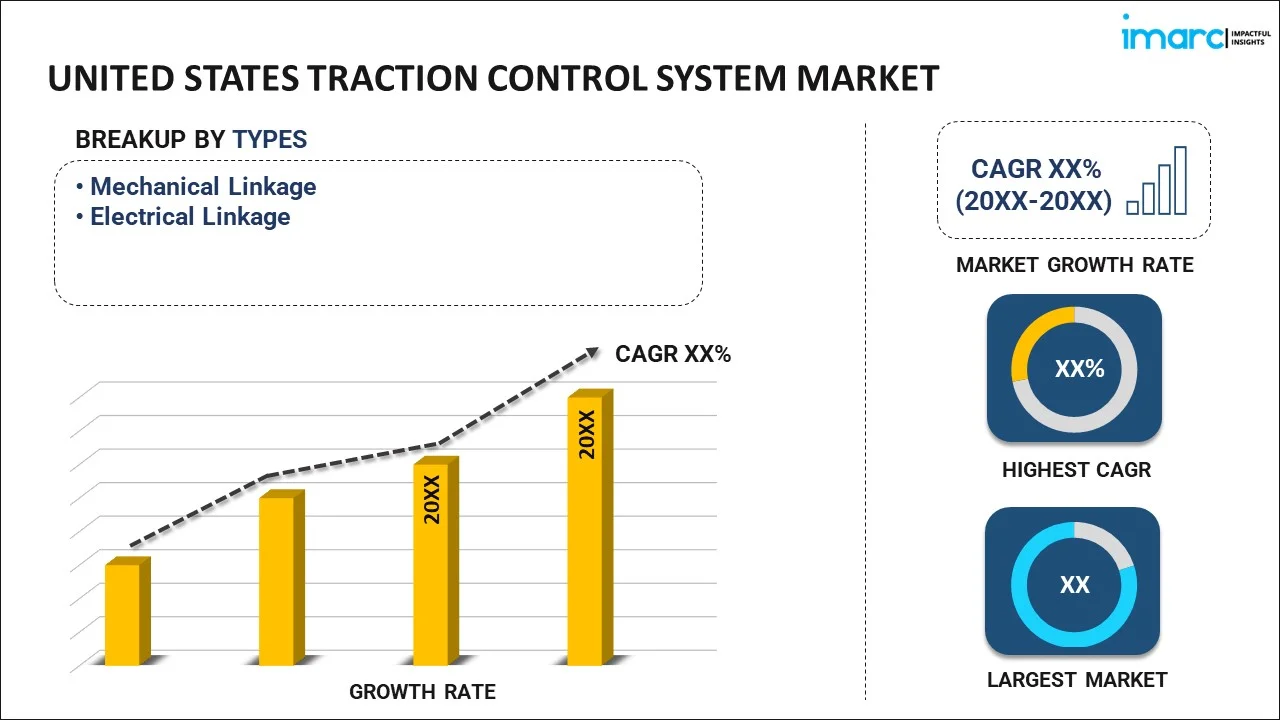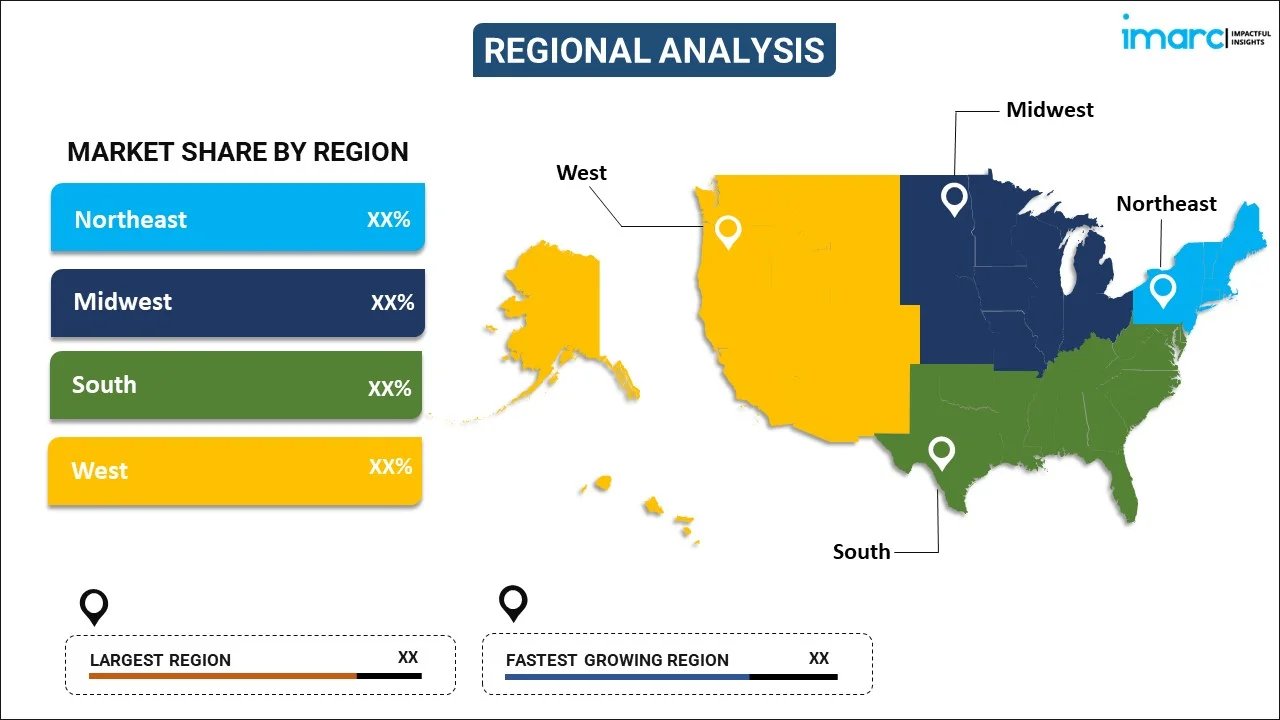
United States Traction Control System Market Report by Type (Mechanical Linkage, Electrical Linkage), Component (Hydraulic Modulators, ECU, Sensors, and Others), Vehicle Type (ICE Vehicles, Electric Vehicles), Distribution Channel (OEM, Aftermarket), and Region 2024-2032
Market Overview:
United States traction control system market size is projected to exhibit a growth rate (CAGR) of 6.52% during 2024-2032. The market is being propelled by factors such as consumers' growing spending capabilities, heightened demand for safety features in vehicles, and substantial research and development (R&D) endeavors.
|
Report Attribute
|
Key Statistics
|
|---|---|
|
Base Year
|
2023 |
|
Forecast Years
|
2024-2032
|
|
Historical Years
|
2018-2023
|
| Market Growth Rate (2024-2032) | 6.52% |
The traction control system (TCS) is an advanced active braking mechanism developed to preserve the traction of a vehicle's tires on surfaces prone to slipperiness or curves, preventing tire slippage during acceleration or deceleration. Its components include a hydraulic modulator, wheel speed sensors, engine throttle position sensors, stop light sensors, and an electronic control unit (ECU). The primary objective of TCS is to assist drivers in maintaining control of their vehicles by averting accidents, minimizing skidding, improving driving stability, and bolstering traction, particularly on slippery terrains. This system is instrumental in heightening safety and stability, especially in challenging weather conditions like rain or snow, and on surfaces with reduced grip. Consequently, it finds widespread application in both internal combustion engines (ICEs) and electric vehicles (EVs), underlining its significance in enhancing vehicular control and safety across diverse driving conditions.
United States Traction Control System Market Trends:
The United States traction control system market occupies a crucial position within the automotive industry, reflecting the nation's commitment to vehicular safety and performance. TCS, an advanced active braking system, is designed to uphold tire grip on challenging surfaces and curves, minimizing the risk of tire slip during acceleration or deceleration. Additionally, comprising a hydraulic modulator, wheel speed sensors, engine throttle position sensors, stop light sensors, and an electronic control unit (ECU), traction control system serves as a critical component for accident prevention and driving stability. In the U.S. automotive landscape, the demand for traction control system is fueled by a collective emphasis on safety features, particularly in adverse weather conditions like rain or snow. Furthermore, this system's ability to enhance road grip and prevent skidding positions it as a cornerstone technology for diverse vehicles, encompassing internal combustion engines (ICEs) and electric vehicles (EVs). Apart from this, technological advancements and a growing awareness of safety contribute significantly to the overall enhancement of driving experiences and the reduction of road accidents, which is expected to fuel the regional market over the forecasted period.
United States Traction Control System Market Segmentation:
IMARC Group provides an analysis of the key trends in each segment of the market, along with forecasts at the country level for 2024-2032. Our report has categorized the market based on type, component, vehicle type, and distribution channel.
Type Insights:

- Mechanical Linkage
- Electrical Linkage
The report has provided a detailed breakup and analysis of the market based on the type. This includes mechanical linkage and electrical linkage.
Component Insights:
- Hydraulic Modulators
- ECU
- Sensors
- Others
A detailed breakup and analysis of the market based on the component have also been provided in the report. This includes hydraulic modulators, ECU, sensors, and others.
Vehicle Type Insights:
- ICE Vehicles
- Electric Vehicles
The report has provided a detailed breakup and analysis of the market based on the vehicle type. This includes ICE vehicles and electric vehicles.
Distribution Channel Insights:
- OEM
- Aftermarket
A detailed breakup and analysis of the market based on the distribution channel have also been provided in the report. This includes OEM and aftermarket.
Regional Insights:

- Northeast
- Midwest
- South
- West
The report has also provided a comprehensive analysis of all the major regional markets, which include Northeast, Midwest, South, and West.
Competitive Landscape:
The market research report has also provided a comprehensive analysis of the competitive landscape. Competitive analysis such as market structure, key player positioning, top winning strategies, competitive dashboard, and company evaluation quadrant has been covered in the report. Also, detailed profiles of all major companies have been provided.
United States Traction Control System Market Report Coverage:
| Report Features | Details |
|---|---|
| Base Year of the Analysis | 2023 |
| Historical Period | 2018-2023 |
| Forecast Period | 2024-2032 |
| Units | US$ Million |
| Scope of the Report | Exploration of Historical Trends and Market Outlook, Industry Catalysts and Challenges, Segment-Wise Historical and Future Market Assessment:
|
| Types Covered | Mechanical Linkage, Electrical Linkage |
| Components Covered | Hydraulic Modulators, ECU, Sensors, Others |
| Vehicle Types Covered | ICE Vehicles, Electric Vehicles |
| Distribution Channels Covered | OEM, Aftermarket |
| Regions Covered | Northeast, Midwest, South, West |
| Customization Scope | 10% Free Customization |
| Report Price and Purchase Option | Single User License: US$ 3699 Five User License: US$ 4699 Corporate License: US$ 5699 |
| Post-Sale Analyst Support | 10-12 Weeks |
| Delivery Format | PDF and Excel through Email (We can also provide the editable version of the report in PPT/Word format on special request) |
Key Questions Answered in This Report:
- How has the United States traction control system market performed so far and how will it perform in the coming years?
- What has been the impact of COVID-19 on the United States traction control system market?
- What is the breakup of the United States traction control system market on the basis of type?
- What is the breakup of the United States traction control system market on the basis of component?
- What is the breakup of the United States traction control system market on the basis of vehicle type?
- What is the breakup of the United States traction control system market on the basis of distribution channel?
- What are the various stages in the value chain of the United States traction control system market?
- What are the key driving factors and challenges in the United States traction control system?
- What is the structure of the United States traction control system market and who are the key players?
- What is the degree of competition in the United States traction control system market?
Key Benefits for Stakeholders:
- IMARC’s industry report offers a comprehensive quantitative analysis of various market segments, historical and current market trends, market forecasts, and dynamics of the United States traction control system market from 2018-2032.
- The research report provides the latest information on the market drivers, challenges, and opportunities in the United States traction control system market.
- Porter's five forces analysis assist stakeholders in assessing the impact of new entrants, competitive rivalry, supplier power, buyer power, and the threat of substitution. It helps stakeholders to analyze the level of competition within the United States traction control system industry and its attractiveness.
- Competitive landscape allows stakeholders to understand their competitive environment and provides an insight into the current positions of key players in the market.
Need more help?
- Speak to our experienced analysts for insights on the current market scenarios.
- Include additional segments and countries to customize the report as per your requirement.
- Gain an unparalleled competitive advantage in your domain by understanding how to utilize the report and positively impacting your operations and revenue.
- For further assistance, please connect with our analysts.
 Inquire Before Buying
Inquire Before Buying
 Speak to an Analyst
Speak to an Analyst
 Request Brochure
Request Brochure
 Request Customization
Request Customization




.webp)




.webp)












